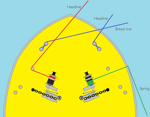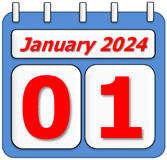 Towing and Mooring Arrangements Plan 01.09.2023 11:19
Towing and Mooring Arrangements Plan 01.09.2023 11:19New Requirements for Towing and Mooring Equipment due to the Amendments to SOLAS
At the 102nd session of the Maritime Safety Committee (MSC102), amendments to SOLAS II-1/3-8 and
"Revised Guidance on Shipboard Towing and Mooring Equipment" (MSC.1/Circ.1175/Rev.1) were
adopted.
Additionally, "Guidelines on the Design of Mooring Arrangements and the Selection of Appropriate Mooring Equipment and Fittings for Safe Mooring" (MSC.1/Circ.1619) and
"Guidelines for Inspection and Maintenance of Mooring Equipment Including Lines" (MSC.1/Circ.1620), were approved. These new guidelines are referenced in SOLAS II-1/3-8. The amendments to SOLAS II-1/3-8 will come into force on 1 January 2024.
1. Application
The following apply to ships of 500 gross tonnage and above engaged in international voyages.
1.1 New ships (SOLAS II-1/3-8 Para.7 or 8)
These regulations only apply to ships:
- for which the building contract is placed on or after 1 January 2024;
- in the absence of a building contract, the keel of which is laid or which is at a similar stage of construction on or after 1 July 2024; or
- the delivery of which is on or after 1 January 2027.
(1) For new ships of 3,000 gross tonnage and above falling under 1.1 (SOLAS II-1/3-8 Para.7) Compliance with MSC.1/Circ.1175/Rev.1 and MSC.1/Circ.1619 is required.
(2) For new ships with a gross tonnage less than 3,000 tons (SOLAS II-1/3-8 Para.8) Compliance with MSC.1/Circ.1175/Rev.1 and, to the extent reasonably practicable, with the requirements of MSC.1/Circ.1619, or compliance with the national standards established by the administration.
1.2 All ships (SOLAS II-1/3-8 Para.9)
All ships (both new and existing ships) are subject to compliance with MSC.1/Circ.1620.
2. Additional new requirements
2.1 New ships
2.1.1 The selection of mooring lines (MSC.1/Circ.1619 Para.5.2.3)
・ Line Design Break Force (LDBF) to be 100% to 105% of the MBLsd
・ Take into account the diameter (D) of surfaces of mooring fittings that are in contact with mooring lines in relation to mooring line diameter (d) (i.e. the D/d ratio) to reduce or mitigate bend loss of strength.
2.1.2 The selection of mooring winches (MSC.1/Circ.1619 Para.5.2.4)
・ To avoid overload on mooring winches, fittings and mooring lines, consideration should be given to select mooring winches with brake capacity of less than MBLsd of the mooring line or with adjustable brake capacity.
2.1.3 The selection of mooring equipment and capstans (MSC.1/Circ.1619 Para.5.2.2)
・ Mooring fittings are to be selected from industry standards in principle, deemed appropriate by ClassNK and are to be at least based on MBLsd.
・ Take into account the diameter (D) of surfaces of mooring fittings that are in contact with mooring lines in relation to mooring line diameter (d) (i.e. the D/d ratio) to reduce or mitigate bend loss of strength.
2.1.4 Technical specification documents for mooring lines
The technical specification documents of the mooring lines provided on board are to include the following (1) to (3) contents.
(1) the manufacturer recommended minimum diameters (D) for fittings in contact with mooring lines
(2) the Line Design Break Forces (LDBF) for mooring lines
(3) the properties of mooring lines related to bend radius (i.e. the D/d ratio)
2.2 All ships
2.2.1 Management plans for inspection and maintenance of mooring equipment (including mooring lines) (MSC.1/Circ.1620)
Since 1 January 2024, all ships are required to keep the management plans on board based on MSC.1/Circ.1620. The management plans shall include the following (1) to (6) contents.
(The numbers in parentheses refer to the paragraph numbers of MSC.1/Circ.1620.)
(1) Procedures for mooring operations, inspection and maintenance of mooring equipment, including mooring lines (3.1)
(2) Procedures to allow the identification and management of mooring lines, tails and associated attachments (3.3)
(3) Manufacturers' criteria for mooring line replacement (4.3.1)
(4) Records of mooring equipment inspections and maintenance, and mooring line inspections and replacement. (4.4.3 and 6.1)
(5) Manufacturers' test certificates for mooring lines, joining shackles and synthetic tails (6.2)
(6) Records of the original mooring design concepts, equipment, arrangements and specifications (4.4.4)
3. To-do items for Shipowners and Management companies (Related to 1.2 and 2.2) The following are the necessary actions that shipowners and management companies need to take:
3.1 Preparation of management plans for inspection and maintenance of mooring equipment (including mooring lines)
For existing ships, the following actions are required concerning the management plans by the first periodical survey of the Cargo Ship Safety Construction Certificate on or after 1 January 2024. For new ships which is delivered on or after 1 January 2024, by the SC initial survey.
(1) All relevant parties, including shipowners and management companies, should obtain the information required in 2.2.1 from the manufacturers regarding mooring lines, mooring equipment, and winches. Utilize and refer to existing SMS manuals and procedures while
preparing the management plans.
(2) Regarding the design concepts at the time of construction mentioned in 2.2.1(6), it is possible to obtain details from "Towing and mooring arrangements plan" or "Equipment Number Calculation Sheet" prepared by the shipyard.
3.2 Maintenance of Management plans for inspection and maintenance of mooring equipment (including mooring lines)
Records of inspection and maintenance of mooring equipment and inspection and replacement of mooring lines shall be retained on board. Such records shall be kept for a period determined by the Company, but in any event the records shall be kept until completion of the next annual survey.
3.3 Replacement of mooring lines
When replacing mooring lines, it is necessary to consider the compatibility with the mooring equipment on board, as indicated in "Towing and mooring arrangements plan" and ensure that the replacement aligns with the original design concept specified in the management plans. If
replacing mooring lines with LDBF (Line Design Break Force) exceeding 105% of MBLsd and deviating from the original design specifications, re-evaluation of mooring equipment and supporting structures may be required.



